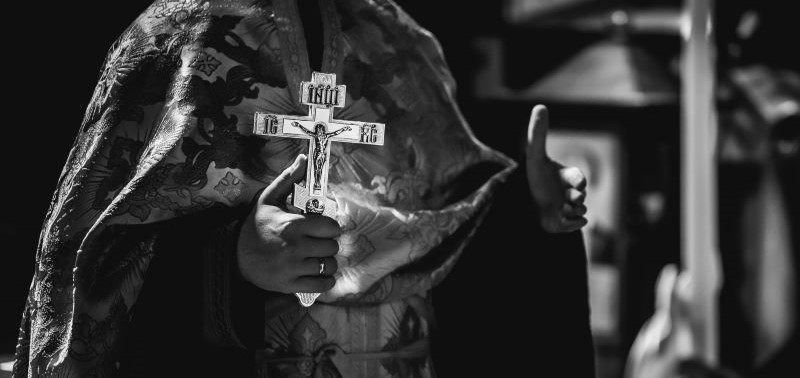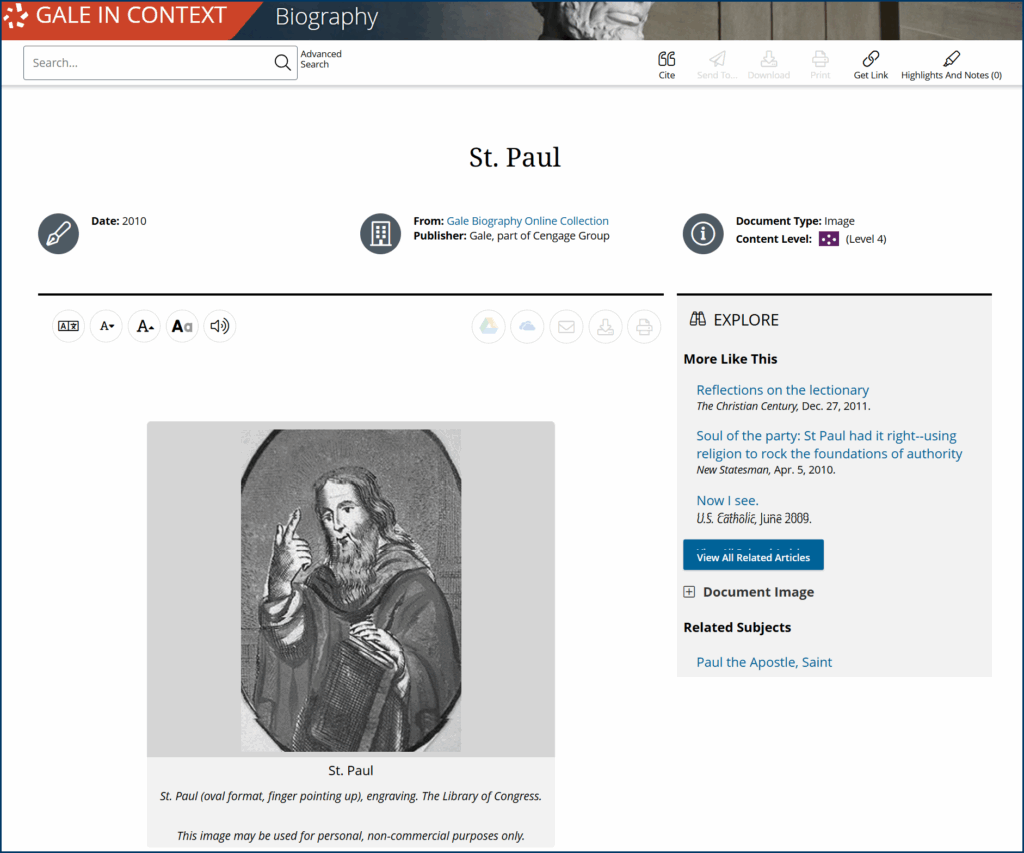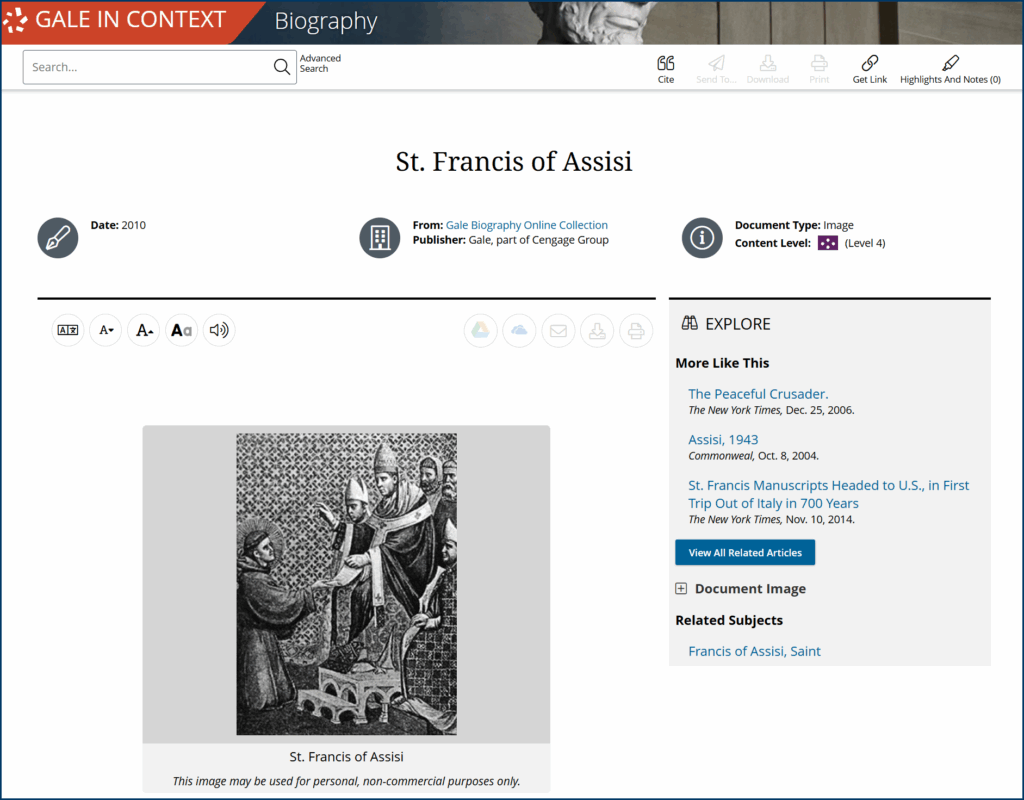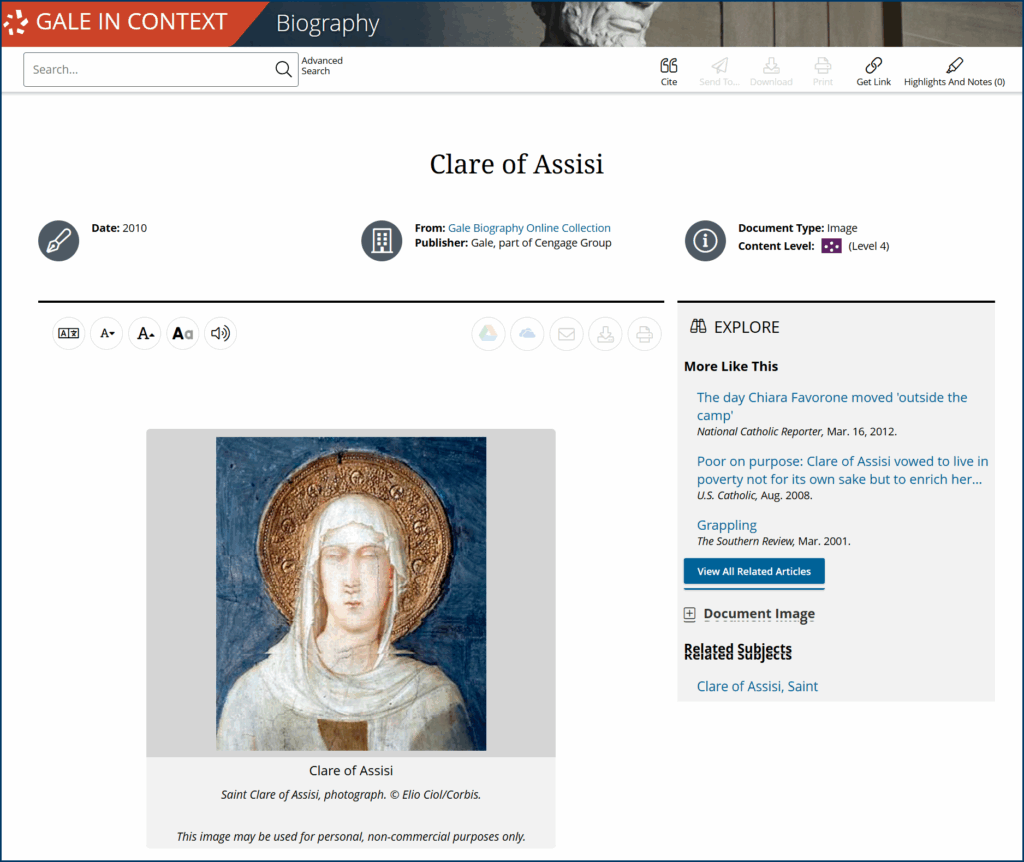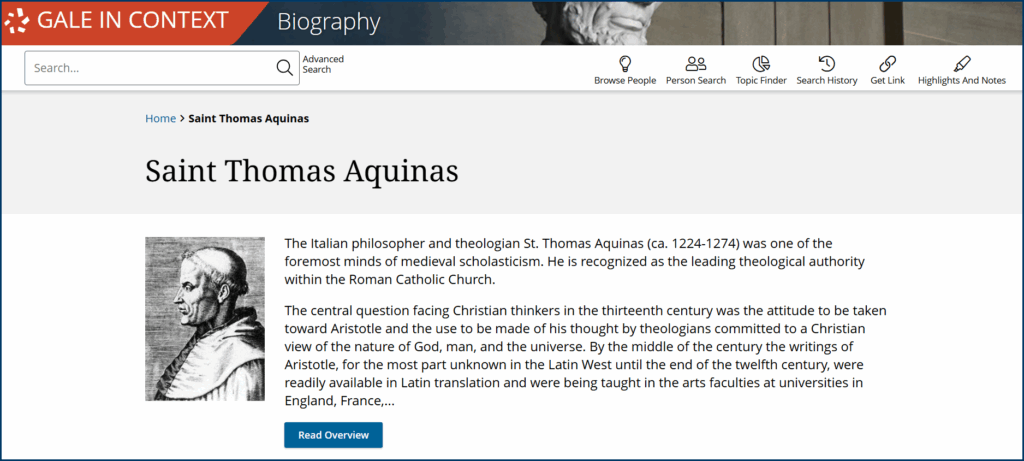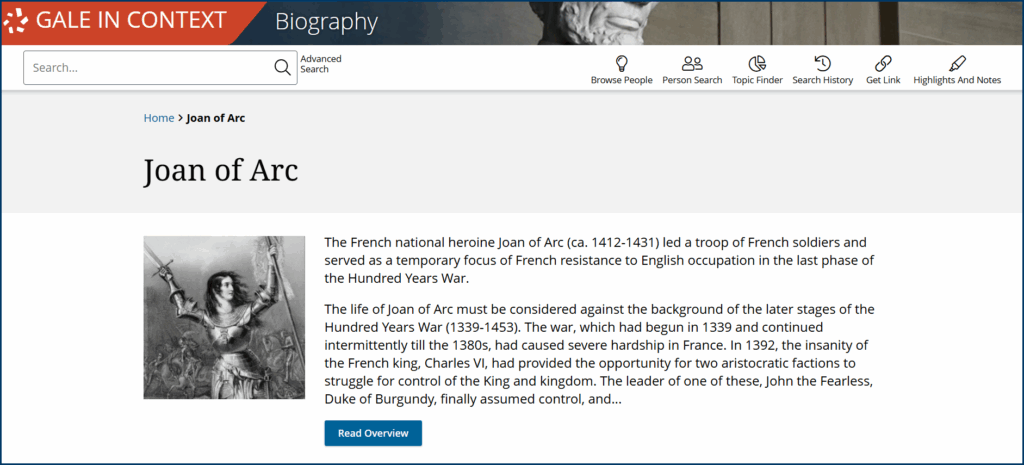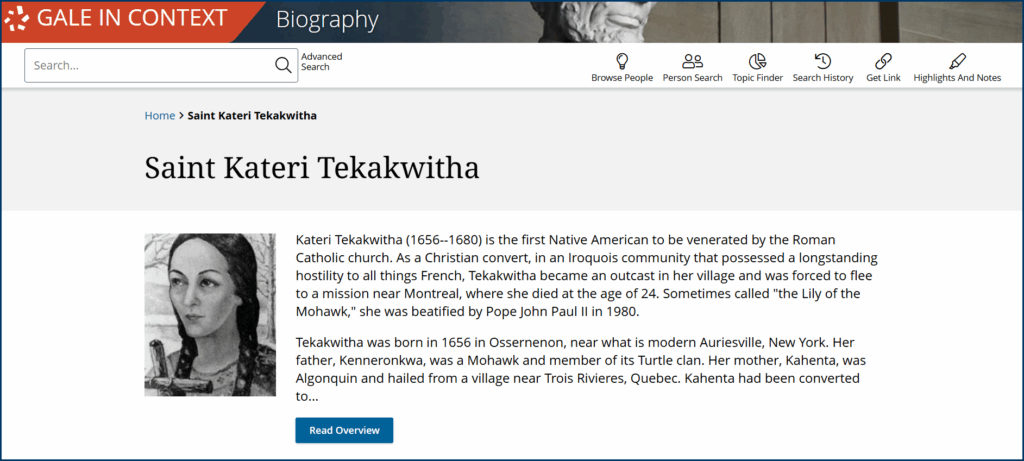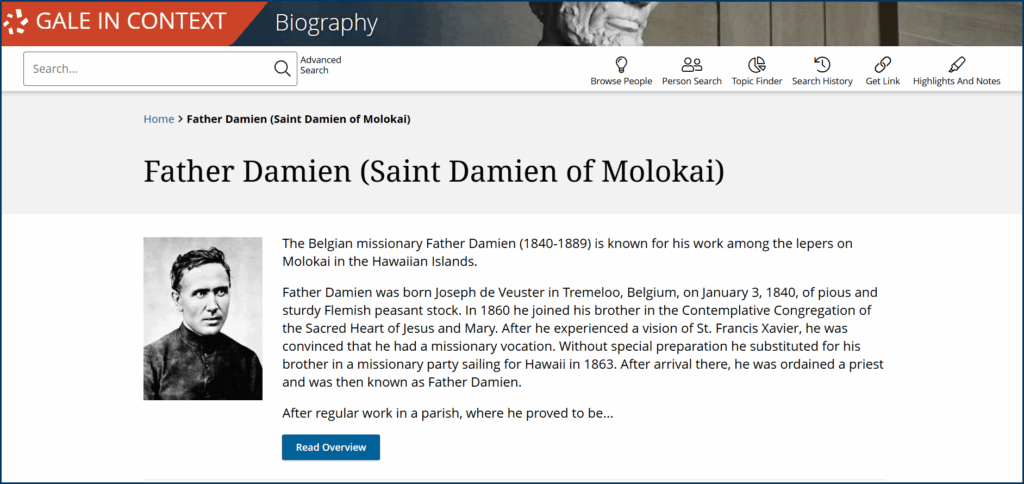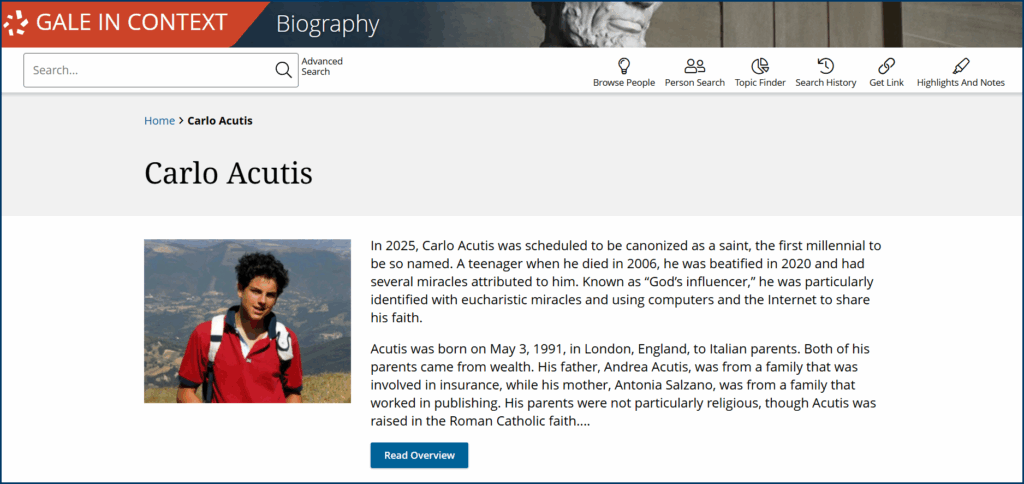Each year on November 1, churches around the world observe All Saints’ Day—a feast honoring a vast and varied group of people whom the Catholic Church recognizes for leading lives of extraordinary faith and virtue. The observance grew out of early Christian practices of honoring martyrs who died for their religious beliefs, later expanding to include those known for their pious deeds and exemplary actions.
To explore the lives of these revered figures, educators can turn to Gale In Context: Biography’s collection of more than 500,000 biographies for accurate, classroom-ready information. Each biography includes a curated set of related materials that enrich the subject’s story—primary texts, historical commentary, media coverage, and multimedia sources.
The collection spans centuries, cultures, and faiths. That means that sainthood becomes one case study among many in how societies commemorate the dead and pass down values across generations.
A Brief History of All Saints’ Day
The earliest observances of All Saints’ Day were in the fourth century, when Christian communities began setting aside days to remember the martyrs—those who had died rather than renounce their faith under repressive Roman rule.
Once Christianity gained legal protection under the Edict of Milan in 313 CE and later became Rome’s state religion, the Church broadened its focus beyond persecuted martyrs to honor other models of holiness. During this period, Church leaders also began consolidating doctrine and formalizing liturgical practices, starting with the Council of Nicaea in 325
Over the following centuries, local communities observed their own feast days for martyrs and regional saints, but the dates and practices varied widely. However, by the eighth century, Pope Gregory III designated November 1 as the date to honor all saints in Rome, and his successor Pope Gregory IV later extended its reach to the wider Church.
Today, All Saints’ Day is part of a three-day observance called Allhallowtide, which includes:
- October 31 – All Hallows’ Eve (Halloween): Once widely observed with fasting and evening prayer, it remains the official vigil for All Saints’ Day, though fewer churches hold Mass for it today.
- November 1 – All Saints’ Day: Honors canonized saints as well as those whose lives reflected extraordinary virtue and faith.
- November 2 – All Souls’ Day: Focuses on prayer for all the faithful departed that are not saints, particularly those believed to be in purgatory or a temporary state of purification before entering heaven.
What Makes a Saint?
For the Catholic Church to declare that someone is a saint, the Church must recognize the individual in question as having lived a life of exceptional virtue so distinct in its moral clarity or spiritual depth that the person is believed to be in heaven and able to intercede for the living.
In the early Church, sainthood was a local designation, often bestowed by widespread acclaim after martyrdom. But since the 10th century, canonization has been a formal papal process involving multiple stages of investigation. Today, that process includes four steps:
- Servant of God: A local bishop initiates canonization after the person’s death, prompting the Church to investigate the person’s writings and reputation for holiness.
- Venerable: After reviewing the evidence, the Vatican’s Congregation for the Causes of Saints declares that the Servant of God lived a life of heroic virtue, meaning they consistently demonstrated virtuous behavior, even in difficult circumstances.
- Blessed: To move forward with beatification, one verified miracle must be confirmed—usually a medically inexplicable healing that occurs after someone prays for the person’s intercession, meaning they ask the candidate to appeal to God on their behalf.
- Saint: Canonization requires a second verified miracle of the same kind, reported after beatification. Because these miracles occur after the person’s death, the Church interprets them as evidence that the candidate is in heaven and able to intercede for the living. At this point, the person is officially recognized as a saint throughout the Church.
Let’s examine the lives and accomplishments of several figures who achieved sainthood, all of whom have entries available through Gale In Context: Biography.
Paul the Apostle (d. circa 64–67 CE)
Venerated since the first century; patron saint of missionaries, writers, and theologians
Once known for opposing Christian communities, Paul experienced a sudden vision of the risen Christ that left him blinded. After recovering his sight and being baptized, he dedicated his life to spreading the message he once opposed.
Paul’s letters—many written from prison—formed some of the earliest Christian theology. He spoke openly about his past violence and spiritual conflict, making his transformation from persecutor to apostle especially powerful.
Ulric of Augsburg (c. 890–973 CE)
Canonized 993; patron saint of weavers and pregnant women
Ulric served as bishop of Augsburg (modern-day Germany) for nearly 50 years, during which time he showed incredible generosity, organizing food and shelter for refugees during Hungarian invasions and distributing aid during times of famine. He was also known for giving handmade garments to the poor, which likely influenced his eventual patronage of weavers.
After Ulric’s death, his widespread local veneration prompted Pope John XV to canonize him in 993—the first time a pope formally approved a saint for public devotion.
Francis of Assisi (c. 1181–1226)
Canonized 1228; patron saint of animals, ecology, and merchants
The son of a wealthy cloth merchant, Francis shocked his community by renouncing his inheritance for a life living among the poor. He tended to lepers no one else would touch and rebuilt ruined chapels with his own hands.
How did Saint Francis’s legacy impact Pope Francis? Read on to learn more.
In his sermons, Francis often praised the Sun, Moon, animals, wind, and water as brothers and sisters in God’s creation. He also wrote The Canticle of the Creatures, one of the earliest pieces of Italian poetry, which celebrates this same sense of harmony between humanity and the natural world. According to one account, he tamed a fierce wolf terrorizing the town of Gubbio, brokering peace between the animal and the townspeople.
That sense of spiritual kinship with all of creation shaped the Franciscan order he founded, which emphasized service and radical joy even in suffering.
Clare of Assisi (c. 1194–1253)
Canonized 1255; patron saint of television writers, embroiderers, and those with eye disease
Born into nobility, Clare defied her family’s expectations by secretly leaving home to join Francis of Assisi in his call to live a holy life in poverty. She founded the Poor Clares, a cloistered order that lived without possessions and dedicated itself to prayer, silence, and manual labor.
Near the end of her life, when she was too frail to attend Mass, Clare reportedly saw and heard the Christmas liturgy projected on the wall of her room—a vision later cited when Pope Pius XII named her the patron saint of television in 1958.
Thomas Aquinas (1225–74)
Canonized 1323; patron saint of students, philosophers, and Catholic universities
Thomas Aquinas was a Dominican friar and scholar whose masterwork, the Summa Theologica sought to explain Christian doctrine through the lens of Aristotelian logic.
During his lifetime, some Church officials were skeptical of Aquinas’s use of Aristotle, whose pagan philosophy was just being rediscovered in Europe through Islamic and Jewish scholars. Many feared that relying on non-Christian sources might undermine theology. However, Aquinas argued that truth discovered through reason could never contradict faith, and he used Aristotelian logic to strengthen—not replace—Christian doctrine.
Joan of Arc (1412–31)
Canonized 1920; patron saint of soldiers and the nation of France
At 17, Joan claimed divine visions instructing her to support Charles VII and help drive out English forces during the Hundred Years’ War.
After convincing royal advisers of her sincerity, she was granted armor and command of troops—an extraordinary act for a peasant girl with no formal training. Her leadership helped turn the tide at the Siege of Orléans, earning her national attention and boosting French morale.
When Burgundian allies of the English captured her a year later, Joan was handed over to a pro-English Church court. She was found guilty of heresy and cross-dressing, then burned at the stake in 1431. A retrial ordered decades later cleared her of all charges.
Kateri Tekakwitha (1656–80)
Canonized 2012; patron saint of Indigenous peoples and the environment
Kateri Tekakwitha, the first Indigenous person from North America recognized as a saint, survived a smallpox outbreak at age four, which left her orphaned, visually impaired, and marked by facial scars.
After converting to Catholicism at 19, Tekakwitha lived a life of prayer and disciplined simplicity. She first devoted herself to her faith within her Indigenous community. Later, faced with the pressure to marry, she fled for a Christian settlement near Montreal where she was determined to become a nun and found a convent. Tragically, she died at the age of 24 before she could realize these ambitions.
Elizabeth Ann Seton (1774–1821)
Canonized 1975; patron saint of Catholic schools and widows
Seton grew up in a New England Protestant family, converting to Catholicism after being widowed with five children. In 1809, she founded the Sisters of Charity—the first community for religious women established in the United States—and opened a free school for girls in Maryland.
Her educational model, which combined academic instruction with religious formation, became the blueprint for the American parochial school system, a network of Catholic schools run by religious orders and parishes to provide accessible, values-based education.
Father Damien of Molokai (1840–89)
Canonized 2009; patron saint for outcasts and people with leprosy and HIV/AIDS
In 1873, Belgium-born Father Damien volunteered to serve at Kalaupapa, a remote peninsula in the Hawaiian Islands where the government forcibly exiled people with leprosy. Cut off by cliffs and rough ocean, the area had little infrastructure and offered almost no medical care.
Damien ministered to both the spiritual and physical needs of the community by building chapels, housing, and a clean water system; dressing wounds; digging graves; and organizing schools and choirs. He also wrote to government officials and newspapers demanding better care. After years of close contact, he contracted the disease himself. He continued working until his death in 1889.
Maximilian Kolbe (1894–1941)
Canonized 1982; patron saint of journalists, prisoners, and those struggling with addiction
During World War II, the Nazis imprisoned Kolbe, a Polish Franciscan friar, at Auschwitz. Before his imprisonment, Kolbe ran one of the largest Catholic publishing operations in Europe, using print and radio to spread religious devotion and speak out against totalitarianism.
When a fellow prisoner was condemned to death, Kolbe stepped forward to take his place—a voluntary act of sacrifice that ended with his execution by lethal injection after surviving two weeks without food or water.
Carlo Acutis (1991–2006)
Canonized 2025; patron saint of the internet and computer programmers
Carlo Acutis grew up in Milan. By middle school, he had already taught himself to code. At age 11, he began building a digital archive cataloging Eucharistic miracles worldwide.
When diagnosed with leukemia at 15, Carlo reportedly said, “I offer all the suffering I will have to undergo for the Lord, for the Pope, and the Church.” In Catholic tradition, this act of offering up suffering means accepting pain or hardship as a spiritual gift that unites personal suffering with the suffering of Christ for the good of others.
Friends remember him as funny, thoughtful, and generous, often giving food or warm words to those in need.
Placed alongside other observances at this time of year, All Saints’ Day reflects a broader human impulse to build connections between the living and those who came before us. It falls in the same period during which Celtic communities lit bonfires and made offerings to the dead during Samhain, and when families in Mexico and Latin America build ofrendas for Día de los Muertos, welcoming the spirits of deceased relatives home for a visit.
These holidays in late October and early November invite students to explore how communities around the world remember their dead and what those practices reveal about our collective identity as human beings.
Connect with your Gale sales representative and request more information about how Gale In Context: Biography can enrich your seasonal lessons with insights into the lives behind these observances and the legacies they left behind.

